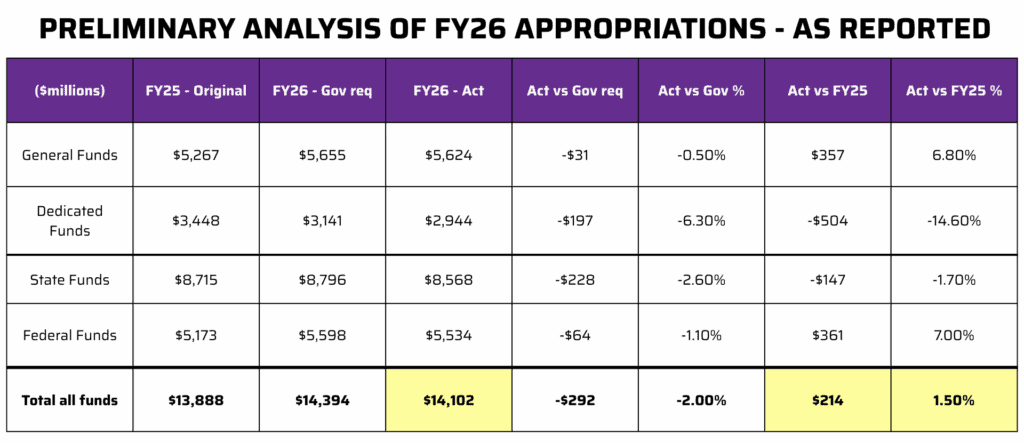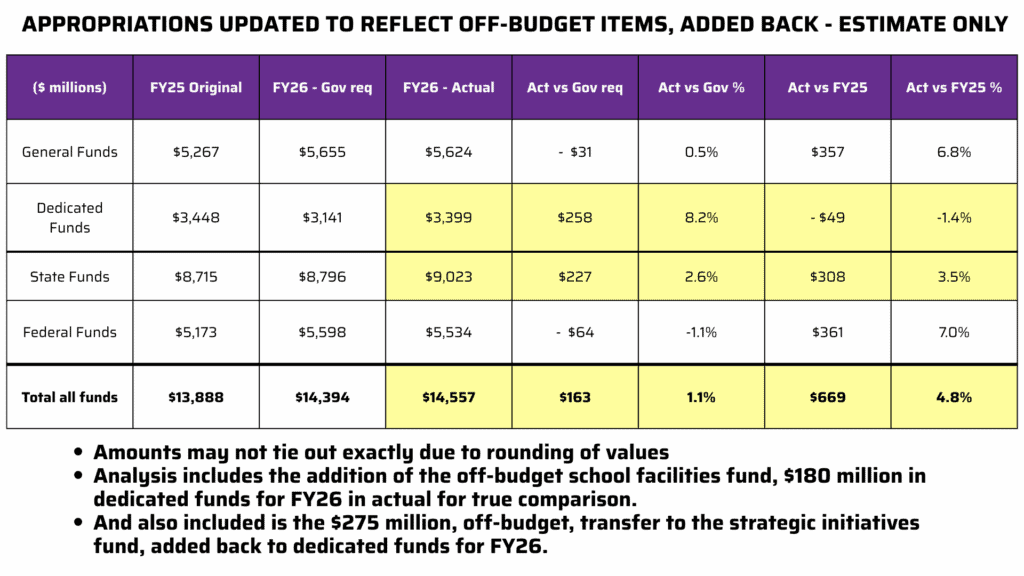



If it hasn’t occurred to you yet that reining in government spending is probably the single most important policy objective (after sealing our borders from invasion) for conservatives, it should. We all experienced how the excessive spending under the Biden Administration ignited inflation and drove the federal debt over $36 trillion.
Is it just a federal problem? In a word, no!
As we have pointed out before, Idaho’s state appropriations have grown in parallel with the surge in federal spending, meaning that over the five prior fiscal years ending with Fiscal Year 2025, appropriations have grown by more than 50% at the state and federal levels.
So, how did the 2025 session, which appropriated the budget for FY26, stack up? Preliminarily, it appears the trend of double-digit growth has been reversed, perhaps even cut in half.
Here is the spending as reported by the Legislative Services Office:

It appears that overall all funds spending only increased 1.5% from the prior year. However, note that while General Fund spending for education, public safety, and general government has increased by 6.8%, Dedicated Funds for items such as roads, bridges, and dedicated agencies like Fish and Game have decreased by 14.6%. What is going on? Well, what has happened is that over the last couple of years, additional budget items have been moved “off the books” and classified as “continuously appropriated funds.” This means that they are not in the above-reported spending categories.
Here is a direct quote from the Budget Going Home Packet sent out on April 4 by the Legislative Services Office (LSO), Budget & Policy Analysis group. “Removed the direct appropriation for the School District Facilities Fund and made this distribution continuously appropriated or ‘off budget’ with passage of HB 304 and HB 481. The FY 2026 estimated distribution is $246,450,000, or $105,520,700 more than was distributed in the current year.”
What is unclear is the exact amount taken off budget overall for FY26, and for FY25, for that matter. IFF sent over the following Public Records Request to LSO: “I would like to please request all records showing the dollar amounts and agencies that continuously appropriated funds in FY24, FY25, and FY26. These are funds that are not counted in ‘original all funds appropriations,’ for which state or federal dollars were continuously appropriated.”
We got this response from LSO: “Good morning. After reviewing your request, LSO has no responsive documents. I suggest contacting the State Controller’s office, they may be able to help.”
This is a very puzzling response because, obviously, LSO calculated the amount for some of the continuously appropriated funds in the Budget Going Home Packet. At this point, we can only estimate the changes in spending based on information we have obtained through conversations, but it is only our best guess.

What we see is that overall spending grew about 4.8%, but we can’t be sure. This is a placeholder until we get better cooperation from state agencies. Moving spending to the continuously appropriated category may have some merit for long-term projects, but it is simply not tolerable to lose visibility of these funds. It is still spending. And it is taxpayers’ money, after all. They should get to see it in official documents on spending.
So, as we stated, our analysis is incomplete at this point, but here are some of the positives.
Idahoans should thank the many legislators who stood tall in reining in spending growth. This includes legislators who made a pledge to reject appropriations that added headcount, grabbed more debt-financed federal dollars, or other new spending beyond what was needed to replace vehicles and other items that wear out. There were also members of the Joint Finance-Appropriation Committee (JFAC) who fought tirelessly to squeeze budgets. It was a difficult task given that the majority of JFAC members view their role as largely giving agencies what they want. And we acknowledge the difficult position that the JFAC co-chairs were in, given the composition of the committee — they should be thanked for encouraging vigorous debates.
By the end of the session, 15 appropriations bills failed on either the House or Senate floors. Most of these were rejected due to the excessive number of new requests for ongoing spending. While we don't know the total impact of killing these bills due to the lack of clarity on continuous appropriations, it appears that these bill rejections reduced the Governor’s General Fund request by over $30 million. While that is small in the overall context of a $14 billion-plus appropriation, it certainly was better than rubber-stamping the Governor’s request. Trimming spending is a herculean task at any level of government, hence why Congress doesn’t seem able to do it. It is our hope that the 2025 session sets the stage for an increased focus on spending next session and that Idaho can lead the way on fiscal conservatism.

